Living: Twelve Steps to Home
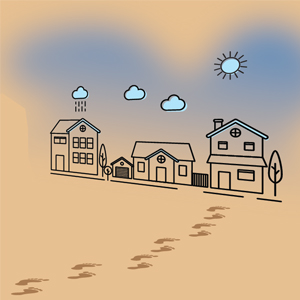
When living in a family that is not aligned with our aspirations, many of us think of changing course. We think of following a dream that would lead to a life very different from the one that we’ve always known, of starting afresh. For most of us, this urge stays confined to the realm of fantasy. But Amanda Sodhi went ahead and put her idea into action.
Growing up in the DC area, she always wished to move to Mumbai to get a break in the Indian music and film industry. At the age of twenty-four, she finally made that move. While Amanda enjoyed the city’s vibe, what did not feel pleasant was living in cramped spaces with roommates and getting jostled in the local trains.
When a promising music lead didn’t bring work and her documentary film project got scrapped, she decided to move to Kolkata instead of going back to the U.S. Kolkata, much more affordable than Mumbai, also offered much better living conditions. But even Kolkata could not be her home for very long.
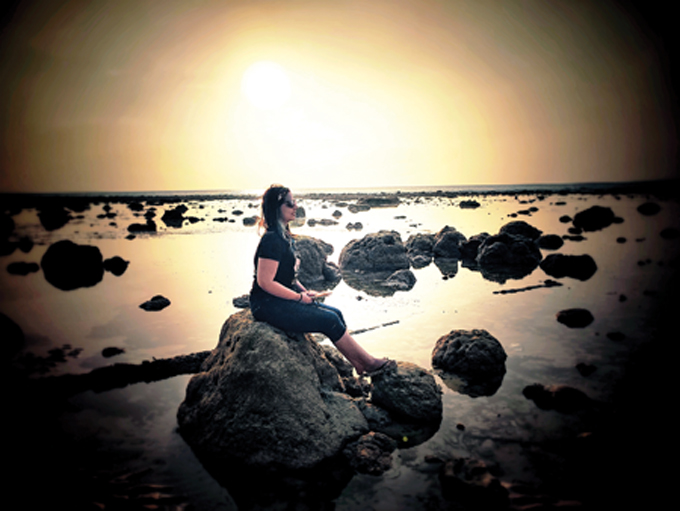 The author in Neil Island, Andaman.
The author in Neil Island, Andaman.
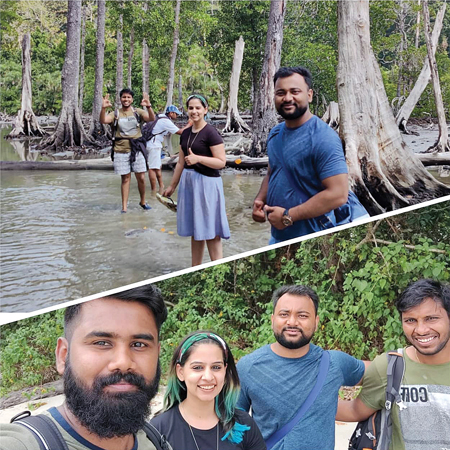
We live in times where we change cities, even countries for the sake of work or for different opportunities. The idea of home and belonging has become harder to define. What is home? What gives us a sense of belonging?
[Right] In Havelock Island, Andaman. With friends she made on her trip to the place.
Last year Sodhi embarked on a journey to answer these questions for herself. It has culminated in her project that she calls, “Twelve Steps to Home” when she spent the last 12 months living in 10 cities. She decided to live out of a suitcase and spend one month in a different city in India for a year.
After having completed her project, Sodhi has come to the conclusion that home is really not so much a place as the people that evoke that feeling of belonging.
Sodhi discusses more in her interview with Khabar:
You have lived in Mumbai for a few years. Tell us something about your time in Mumbai.
I lived in Mumbai for four-and-a-half years. It was an interesting phase. I had spent most of my life fighting to move to Mumbai, so I felt inner peace when I finally did what I had always wanted to. However, navigating the film and music industry was not so straightforward. There was a lot of culture shock, a lot of sexual harassment, and a lot of towering egos to confront. That said, I enjoyed the overall vibe of Mumbai, the number of work opportunities that exist, the number of interesting events happening throughout the week, and the chilled-out people you’ll always come across. I also felt very safe in Mumbai, including at odd hours—perhaps even safer than in some parts of the U.S.
However, I also felt most equations in Mumbai are transactional, perhaps because everyone is trying to survive at any cost. Mumbai isn’t an easy place to live in if you’re on a budget.
Tell us something about your time in Kolkata.
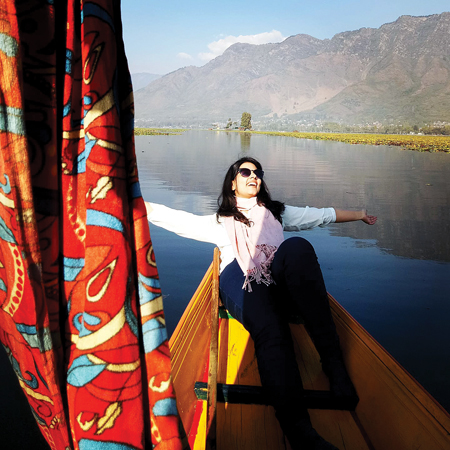 Towards the end of my stay in Mumbai, I felt very disheartened. Despite a tweet from A. R. Rahman about my song Behind My Sunglasses, there was zero work coming through. A documentary that I was working on and which, I thought, would work wonders for my career as a filmmaker, also got canned. I was debating if I should move back to the U.S. or if I should try out another city. I figured that I always have the option of moving back to the U.S., so why not try out another city within India and see if the experience there is better. And so, I moved to Kolkata because it had an old-world charm about it that was appealing. Plus, so many artists have emerged from this city, hence I figured there must be something to it.
Towards the end of my stay in Mumbai, I felt very disheartened. Despite a tweet from A. R. Rahman about my song Behind My Sunglasses, there was zero work coming through. A documentary that I was working on and which, I thought, would work wonders for my career as a filmmaker, also got canned. I was debating if I should move back to the U.S. or if I should try out another city. I figured that I always have the option of moving back to the U.S., so why not try out another city within India and see if the experience there is better. And so, I moved to Kolkata because it had an old-world charm about it that was appealing. Plus, so many artists have emerged from this city, hence I figured there must be something to it.
[Left] At Dal Lake, Srinagar.
Kolkata is a very affordable place to live. My quality of life improved—I could rent a one bedroom apartment with a balcony that offered a gorgeous view for less than the money I was spending to share a tiny room with someone else in Mumbai. Strangely, I did more work in music in the first year of my move to Kolkata than I did in all my time in Mumbai. I was in a better headspace and could come up with ideas for new projects, including my startup, Pen Paper Dreams. However, there’s a lot of brain drain happening in Kolkata. So, it was very challenging to meet people in my age bracket, which eventually led me to feel isolated. In essence, towards the end of my three-and-a-half years’ stay in Kolkata, I felt the same as I did at the end of my four-and-a-half years’ stay in Mumbai—pretty alone and disconnected. I don’t think the issue is with any city per se, but perhaps more an internal one. Or perhaps society doesn’t know what to do with single women in their 30s in India, so you’re bound to feel isolated no matter where you go.
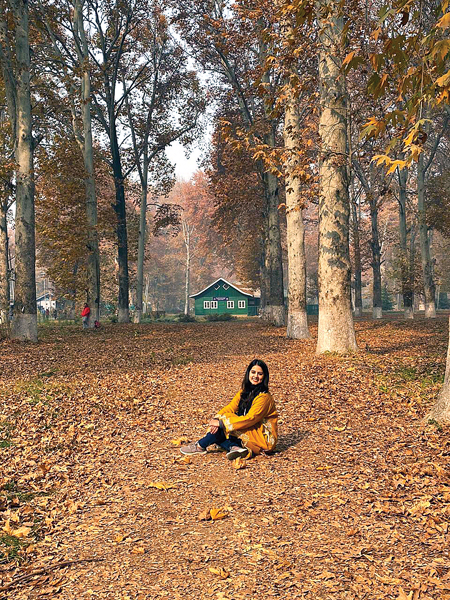
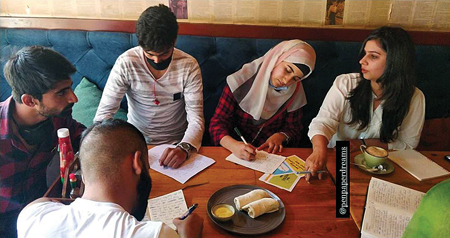
You said that spending 30 days in a city is enough to see if it sparks your interest. Did you find any place like that? Would you want to spend more time there?
Both Hyderabad and Srinagar sparked my interest quite a bit, which is why I am going to divide my time between these two places in 2022. Hyderabad reminds me of Kolkata in many ways—the slow pace, the old-world charm in certain parts of the city; and yet there are way more people in my age bracket than there were in Kolkata. And, Kashmir isn’t a place, it’s an emotion.
Traveling alone has its challenges, especially if you’re a woman. What were some of those challenges and were there things that made your travels more enjoyable?
There’s a lot of eve-teasing that happens when you travel alone as a woman, especially if you like to walk alone. Sometimes, I ignore it. Sometimes, I plug in my earphones and blast loud music. Sometimes, I stop and confront the eve-teaser. Sometimes, I’ll get on a call with a friend while walking to feel safer. It really depends.
[Left] At Kashmir University, Srinagar
[Bottom] Conducting a creative writing workshop at Books & Bricks Cafe, Srinagar.
I think the larger challenge solo female travelers face in India is that a lot of people get judgmental or assume certain things about you. Many people think traveling solo is “ameeron ke chonchle.” (“Frivolities of the rich”). But that is not true—I spent less living out of a suitcase for 12 months than I would have if I lived in Mumbai for a year. There are a lot of taunts you face as well, maybe because you’re viewed as a threat for being independent. I remember one woman told me that it’d be difficult for me to get married because potential in-laws will think “iska zaroor har city mein ek boyfriend raha hoga iss saal.” (“She certainly must have a boyfriend in each of the cities she travels.”). And then one man told me he was insecure that I was comfortable traveling alone because that means I don’t “need” anyone and have a “more happening life” than him.
You mention the fact that some people are willing to share their deepest secrets with you because you’d be leaving at some point. From their end, you’re their confidant. Have there been instances when you feel that you might want to stay longer and create a bond with them?
Yes, there were times I felt there was an actual friendship that existed between me and certain people. It was later that I realized that they felt they could emotionally dump things because it felt safe for them to do so since I was a traveler and the minute I left, so would their secrets with me. There was a use-and-throw attitude some people adopted. You live and you learn. Traveling has made me a bit more jaded.
You mention the tug between independence and creating meaningful connections. What are some of the ways in which you think you can make meaningful connections and did your travels help you in identifying them?
In India, most people’s first circle of friends consists of cousins and childhood neighbors. Then, schoolmates and college buddies. Then, workplace friends, the people they meet at the gym or other hobby classes, or neighbors. And, if they are married or have kids, friends connected with their spouse or their children’s circle. To enter someone’s close circle of friends in your 30s becomes very challenging, especially as a single woman. I haven’t really found an answer to how I can identify and form better friendships.
The way friendships are formed, treated, and maintained in India is drastically different from the U.S. People nurture their friendships beautifully in the States, and there are many platforms to make healthy friendships, including Meetup groups.
Any one place that you found breathtaking/exceptional?
I found Andaman, Kashmir, and Kerela to be exceptionally beautiful.
Did solo travel make you discover anything about yourself? Any hidden strengths that became apparent?
Over the years, I’ve understood I’m resilient. But, this year, I really pushed myself mentally, emotionally, and physically. There were many locations where I had zero support system in place. I hadn’t known I was capable of persevering when I had hit rock bottom.
You said Kashmir is an emotion. Would you be able to describe that a bit more?
It’s a place where both beauty and pain run parallel. While this might not be politically correct to say, but perhaps it’s so broken I feel I fit right in.
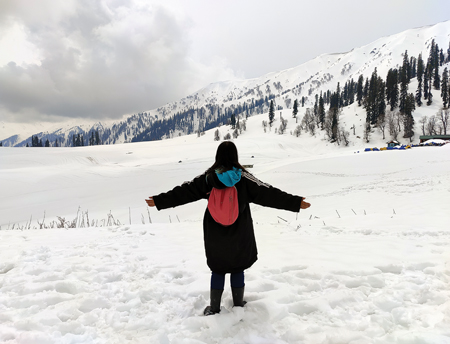 [Right] At Gulmarg, Kashmir.
[Right] At Gulmarg, Kashmir.
I understand that your motivation in the “Twelve Steps to Home” project was to investigate the notions of home and belonging. Would it be accurate to say that now your notion of home is not so much a place as people? Do you think if you would ever feel at home anywhere?
I don’t think I would ever feel at home anywhere because home isn’t a place, it’s people. I had a hunch this would be the case. That’s what we’re brainwashed into thinking—that home is always people or family. I had hoped my definition would change through this journey. Instead, it only underscored how true this conventional definition is, and a part of me feels doomed—what if I always feel there’s no home in my life? Not having a strong sense of family can really mess with your mind. Through therapy, I recently realized that my inability to feel I belong anywhere might be rooted in trauma. Hopefully, the journey of healing through therapy may help in finding a sense of home at some point. At the moment, it feels exhausting to not have any place to return to or any people to fall back on blindly.
I understand your statement about society not knowing what to do with single women in their 30’s in India and feeling isolated because of that. But is there any advantage to not fitting in the prescribed roles?
Sure, one always has a sense of satisfaction that they stayed true to who they are... that they didn’t allow others to force them into a conventional box. But it is isolating to feel like a misfit. Hope that the tribe of misfits grows, and we all find each other and form a structured community. (laughs)
Is there anything about your life in the U.S. that you miss?
Yes, I miss the sense of structure, the number of professional opportunities, the many platforms that exist to easily make friends, the cherry blossoms in DC, the gorgeous weather of Los Angeles, the inspiring pulse of cities like New York. And the guacamole at Chipotle. (laughs) There’s a lot I do miss.
Is there any aspect of living in India that makes you want to continue living there?
Probably fear. If I move back to the U.S., I would have to go back to a nine-to-five routine to sustain myself financially, which I don’t think I can do anymore. I’m not as malleable as I was in my early 20s. Furthermore, the thought of having to start from scratch again is scary. Yes, I’m a U.S. citizen, but I don’t have a home there—figuring out the housing situation while job-hunting, which could take many months in the current economy, is frightening. I’d probably run out of savings pretty quickly! (laughs) Sometimes, I toy around with the idea of applying for a writing fellowship outside of India. Dekhte hain. As of now, I’m still married to the idea of living in India, maybe because I’ve invested so much time here. Or perhaps I’ve started to find comfort in the chaos here.
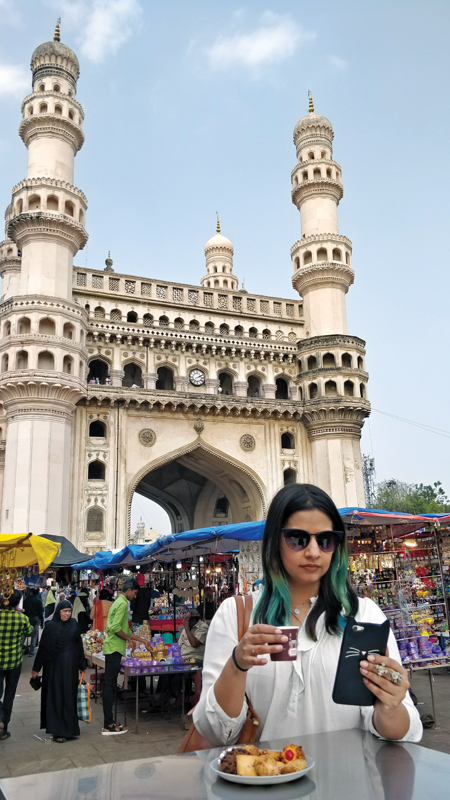
You mentioned your time in Andamans in another interview. Would you be able to describe one interaction with the people there that was good?
I was staying at Goldie’s Hostel in Havelock island, and the owner introduced me to a few of his friends who were visiting from Port Blair. We all went night kayaking that same day and then trekked to Elephant Beach in the morning, which was fun. Later, when I was in Port Blair, they went out of the way to make me feel comfortable throughout my entire stay. I never felt alone even once during that month.
Could you describe one scene from Andaman and one from Kashmir that was beautiful?
Seeing tons of deer and peacocks roaming freely at Ross Island was incredible. And going snorkeling in Andaman was surreal.
In Kashmir, everything is beautiful. It’s like one giant painting that keeps on unfolding. Although I grew up with a lot of snow in DC, when I went to Gulmarg, it was unbelievable. I felt like I had stepped into Narnia.
[Left] At Charminar, Hyderabad.
I completely understand your position about moving back to the U.S. and starting afresh. As a person without a nine-to-five structure in India, how are you able to sustain yourself financially?
I freelance in India, and although it’s not the most lavish lifestyle, it offers me a lot of freedom and flexibility. I am always on my toes to keep pitching for new clients. I send out nearly 50-100 pitches each week, that might lead to a few inquiries, and then that might actually lead to a new client eventually signing on. It’s not an easy path.
I was able to birth Pen Paper Dreams, a startup that helps others heal through creative self-expression, primarily a variety of writing workshops. Initially, I only conducted sessions in Kolkata. Then, I started scheduling workshops in different cities that I would travel to. In the pandemic, we took these workshops online which allowed people to attend from any location.
Atlanta-based Aruna Padmanabhan is a freelancer who writes about her penchant for eco-tourism, nature, and wanderlust.
Enjoyed reading Khabar magazine? Subscribe to Khabar and get a full digital copy of this Indian-American community magazine.
blog comments powered by Disqus










